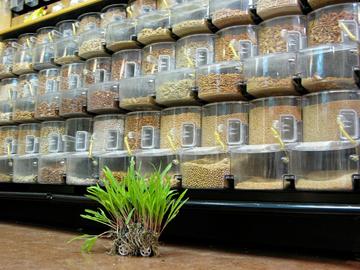MAINSPACE EXHIBITION /

Monsantra
Wendy DesChene & Jeff Schmuki
May 3 to June 16, 2012
Using GMO seed obtained from the Monsanto Corporation, DesChene and Schmuki have grafted genetically modified food plants onto remote controlled robotic bases, constructing artificial hybrid organisms with no clear heritage or future.
Like any traditional B-movie monster, Monsantra is a unexpected hybrid of imagination, possibility and reality. Using GMO seed obtained from the Monsanto Corporation, artists Wendy Deschene & Jeff Schmuki have grafted genetically modified food plants onto remote controlled robotic bases, constructing artificial organisms with no clear heritage or future. Primarily these poetic plant/robot hybrids beg the questions: what long-term effects will genetically modified food have on those who consume it – and on the land it’s grown on?
AgriCULTURE
How did we get here? And, did we really think we could outsmart nature? Science without conscience or ethics is definitely not smart. In a capitalist economy, we can understand how it happens. But, how could anyone in his or her right mind believe that altering nature beyond simple hybridizations could be a good thing in the long run? When Luther Burbank undertook his investigations into hybrid grafting and crossbreeding of plants at his experimental farm in Sebastopol, California in the late 1800s, his intentions were to modify or alter nature in ways that would benefit agricultural shortcomings. His contributions include the Burbank potato that was introduced in Ireland to help combat the blight epidemic, and several varietals of fruits that eventually paved the way for the Green Revolution. The predecessors of Genetically Modified Organisms (GMOs) were straightforward and it was exciting to know that humans could collaborate with nature to benefit humankind.
However, the real concern is how far should we go with this collaboration, an unknown territory merging commercially driven scientific experiments with natural processes. Enter Frankenfoods…. having grown up on a farm myself, the idea that something was wrong with my food arose in the 1990s, when I could not find a good tomato anywhere for years. They were all mush. In fact, I gave up eating my favorite fruit because they were basically uneatable. This is obviously a problem for a whole generation of now young adults who have grown up thinking these tomatoes are normal and who continue to eat them today.
In the entire USA, Trinity, Marin and Mendocino in Northern California are the only counties that have been able to pass legislation banning GMOs. Percy Schmeiser from Saskatchewan who was featured in Debra Koon’s documentary The Future of Food in 2005, one of the first documentaries that addressed GMOs, spent his life savings to fend off Monsanto who sued him for stealing seeds that he never even wanted or had any control over their distribution, a purported crime that truly defied all logic. Schmeiser finally won after almost a decade in 2008. Also in 2010, Bill Gates purchased 500,000 shares of Monsanto stock valued at more than $23 million while his nonprofit the Gates Foundation is funding biotechnology programs, introducing GMOs to poor communities around the world. And, the Long Now Foundation, and its founder “ageing hippie technophile” Stuart Brand, who supports long term thinking, believes GMOs are a necessity to feed a starving planet. But is this really long-term planning when we are abandoning seeds that have been around for thousands of years?
Artists such Alexis Rockman (paintings), Christy Rupp (sculpture), and Steve Kurtz with the Critical Art Ensemble (public sphere performance) have questioned this world of modifying nature to feed a growing population. And, an important exhibition that also explored these issues over a decade ago was Paradise Now first presented 2001 at Exit Art in New York City. Monsantra by Wendy DesChene and Jeff Schmuki expands on the GM dialogue by reaching out into communities with their solar powered portable Genetic Field Lab and hybrid robotic PlantBots in 2010 and 2011. More recently they have created a Mobile Incubator and Educational Gallery out of a converted 18 foot long trailer that serves as a roving Art Lab or nucleus that can move from city to city, state to state, where they present their PlantBot Workshops. Employing satire in the public sphere, their interventions educate about the absurdities of genetically modified foods in a playful way.
– Patricia Watts
Biographies
Canadian Wendy DesChene and American Jeff Schmuki began practicing together as an artist team in 2008. Both artists have personal exhibition experience and numerous awards as solo artists before gaining the experience that has formed the basis for their collaborations. Their first award as a team was a residency award at the American Academy in Rome. Monsantra has been previously exhibited at the Carnegie Museum of Art in Pittsburgh and the Goethe Institute in Cairo. While working with the Department of Engineering at Auburn University (Auburn, Alabama), they also created an interactive community project at the Jules Collins Museum of Art. In 2009 they made a significant contribution to this ongoing body of work while the pair were artistic research fellows at I-Park in Connecticut. www.monsantra.com
Patricia Watts is founder and west coast curator of ecoartspace, a nonprofit platform for artists addressing environmental issues in the visual arts. She has researched art and nature practitioners since 1994, has curated over twenty exhibitions related to art and nature, and has given lectures at art departments internationally. Watts was Chief Curator at the Sonoma County Museum in Santa Rosa, CA (2005-2008).
